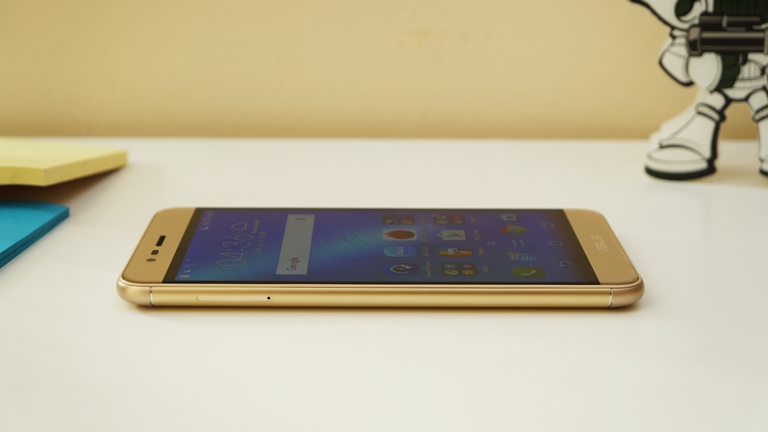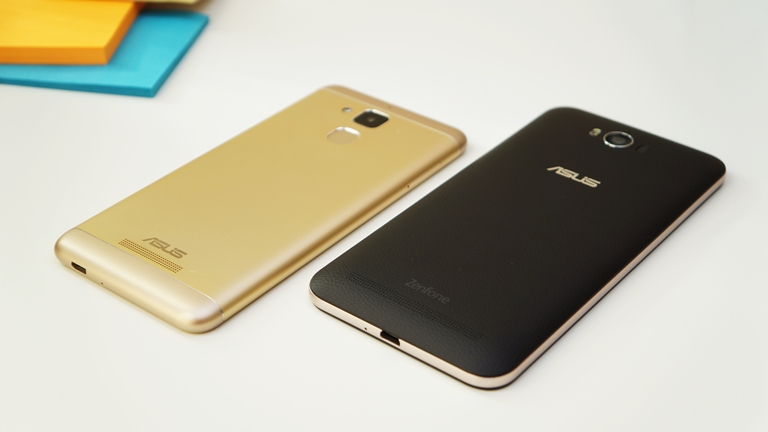Apart from the Zenfone 3 Laser, another new member of the Zenfone 3 family is the Zenfone 3 Max. This is the successor of the famous Zenfone Max known for its big battery capacity. Here’s our quick hands-on and initial impressions of the device.

To start, the Zenfone 3 Max now has a smaller display at just 5.2-inches but still retains a 720p resolution giving it a tad sharper 282ppi pixel density. It’s still not as sharp as we wish it to be but the lower resolution helps keep it chugging longer. There’s a 5MP selfie camera above along with the earpiece and necessary sensors. Unlike its predecessor, it now uses onscreen buttons for UI navigation.

The right-hand side has the usual pair of power/lock buttons and volume keys.

The left side of the device has the hybrid card tray for two Micro-SIM cards or a microSD card for storage expansion.

The top side just has the 3.5mm headphone jack leaving the bottom end to house the microUSB port for charging and data connectivity and microphone pinhole.

Coming from a faux-leather back panel, the new Max now has an aluminum shell sealing the battery inside. Since it has a smaller body, the battery is reduced to 4100mAh capacity. That’s 800mAh shy from the original Max. The main camera though is still a 13MP shooter with an LED flash but the laser AF sensor is nowhere to be found. In return, you’re getting a rear fingerprint scanner.

Powering the Zenfone 3 Max is a MediaTek MT6753T quad-core chipset clocked at 1.5GHz and is paired with a Mali-T720 MP2 GPU. There’s an upgraded 3GB of RAM and a staple 32GB of expandable storage. That being said, the new Max on Antutu v.6.1.4 benchmark was able to score 40190. The change to a MediaTek chipset puts a question mark on the battery life of the phone. We’ll see how it fairs when we get our own unit.

The camera department, in terms of megapixel count, has not changed. We still have a 13MP main shooter but with the exemption of the laser AF and a 5MP selfie camera. Here are a few initial samples:
Judging from the samples above, photography is not surprisingly the feat of the Max, especially in low-light. We weren’t able to take some samples in daylight so we’re not jumping to extreme conclusions here.

So what has changed after a half-year existence of the original Zenfone Max? It now has a better aluminum body, a more attractive design, and has a fingerprint scanner on its back. The dismissal of the Laser AF is not actually a concern since this handset is more focused for road-warriors rather than mobile photography enthusiasts.
ASUS Zenfone 3 Max specs:
5.2-inch IPS LCD @ 1280 x 720 pixels, 282ppi
1.5GHz MediaTek MT6753T quad-core processor
Mali-T720 MP2 GPU
3GB RAM
32GB internal storage
Expandable via microSD (uses SIM2)
13MP autofocus rear camera w/ LED flash
5MP front-facing camera
Dual SIM (Micro-SIM)
4G LTE
Wi-Fi 802.11a/b/g/n
Bluetooth 4.1
GPS w/ A-GPS, Glonass
Fingerprint scanner
Android 6.0 Marshmallow
The new ASUS Zenfone 3 Max is expected to be officially launched next month along with a number of incoming ASUS notebooks, convertibles, and smartphones. Pricing is still a blur, well locally, but Vietnam is having it for 4,490,000 VND (~Php9,500USD 162INR 13,724EUR 154CNY 1,179). We’ll be covering the Philippine launch of the new Max, stay tuned for more updates.

YugaTech.com is the largest and longest-running technology site in the Philippines. Originally established in October 2002, the site was transformed into a full-fledged technology platform in 2005.
How to transfer, withdraw money from PayPal to GCash
Prices of Starlink satellite in the Philippines
Install Google GBox to Huawei smartphones
Pag-IBIG MP2 online application
How to check PhilHealth contributions online
How to find your SIM card serial number
Globe, PLDT, Converge, Sky: Unli fiber internet plans compared
10 biggest games in the Google Play Store
LTO periodic medical exam for 10-year licenses
Netflix codes to unlock hidden TV shows, movies
Apple, Asus, Cherry Mobile, Huawei, LG, Nokia, Oppo, Samsung, Sony, Vivo, Xiaomi, Lenovo, Infinix Mobile, Pocophone, Honor, iPhone, OnePlus, Tecno, Realme, HTC, Gionee, Kata, IQ00, Redmi, Razer, CloudFone, Motorola, Panasonic, TCL, Wiko
Best Android smartphones between PHP 20,000 - 25,000
Smartphones under PHP 10,000 in the Philippines
Smartphones under PHP 12K Philippines
Best smartphones for kids under PHP 7,000
Smartphones under PHP 15,000 in the Philippines
Best Android smartphones between PHP 15,000 - 20,000
Smartphones under PHP 20,000 in the Philippines
Most affordable 5G phones in the Philippines under PHP 20K
5G smartphones in the Philippines under PHP 16K
Smartphone pricelist Philippines 2024
Smartphone pricelist Philippines 2023
Smartphone pricelist Philippines 2022
Smartphone pricelist Philippines 2021
Smartphone pricelist Philippines 2020
Zaph F. Castillo says:
http://www.phonearena.com/news/MediaTeks-MT6735-SoC-beats-the-Snapdragon-410-chipset-in-benchmark-tests_id68455
Ako says:
Yes! may bagong picture si Papa Daniel. Pogi yummy!!
Norven says:
Should we call this “Upgraded” zenfone max, or simply “another version” zenfone max? Maybe the latter is more appropriate. You can’t upgrade a phone by sizing down the display and battery, eliminating the useful Lazer AutoFocus camera and replace it with the more on luxury side Fingerprint Scanner. In my opinion.
Atong says:
Was there any info for the charging time?
Johnny says:
Ang pogi ni Daniel Morial sa selfie huhuhu, gusto ko siya maka-one night stand. One night lang, kasi pag more than one night baka ma-in love ako sa kanya.
burn says:
hi, alin po ang tama? MediaTek 6737T o MediaTek MT6753T?
paki ayos po, salamat
Powering the Zenfone 3 Max is a MediaTek 6737T quad-core chipset clocked at 1.5GHz and is paired with a Mali-T720 MP2 GPU.
ASUS Zenfone 3 Max specs:
5.2-inch IPS LCD @ 1280 x 720 pixels, 282ppi
1.5GHz MediaTek MT6753T quad-core processor
Mali-T720 MP2 GPU